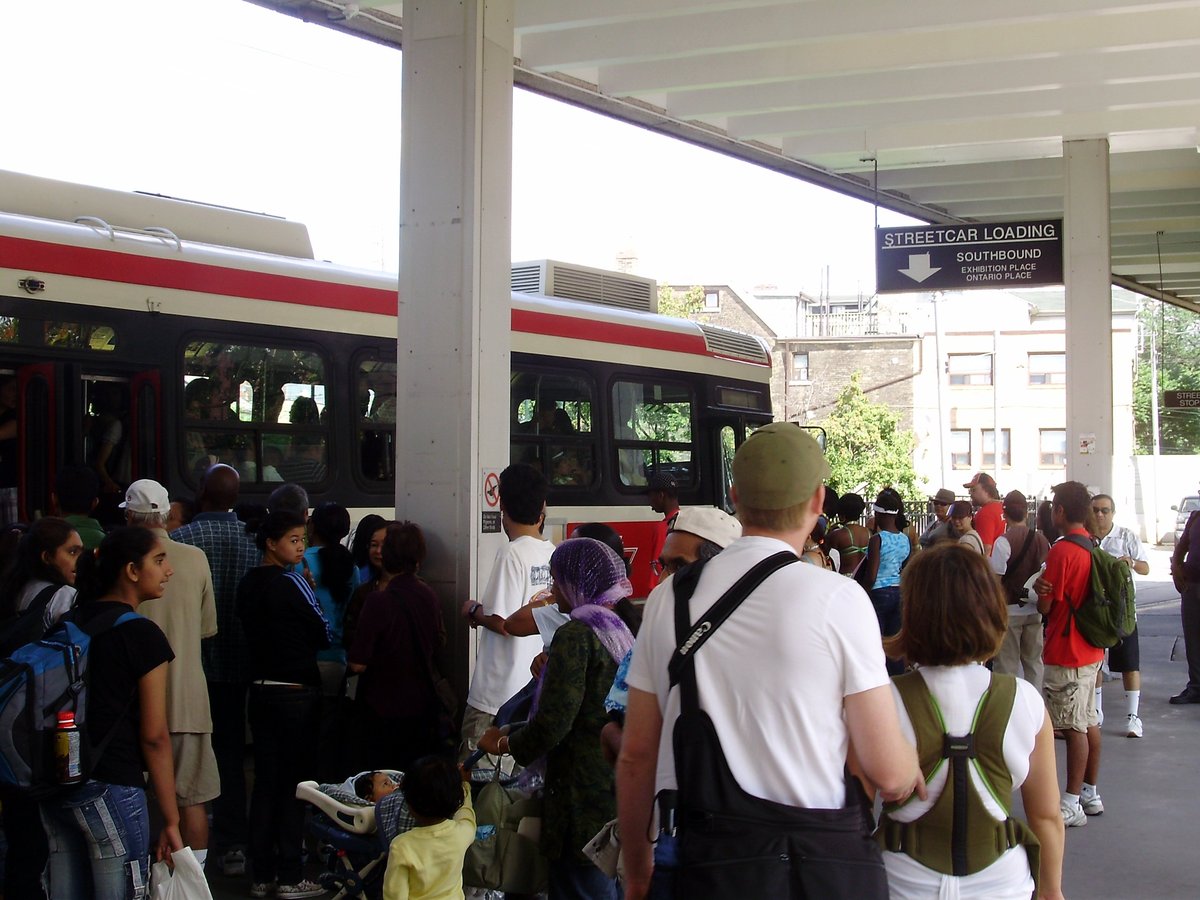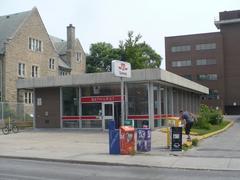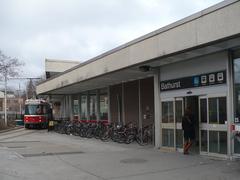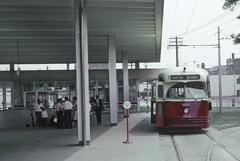
Bathurst Street, Toronto, Canada: Comprehensive Visiting Guide, Tickets, Hours, and Top Attractions
Date: 15/06/2025
Introduction: Bathurst Street’s Historical and Cultural Significance
Bathurst Street is more than just a thoroughfare in Toronto—it is a vibrant corridor with deep historical roots, cultural diversity, and architectural heritage. Its origins trace back to the late 18th century, beginning as “Crookshank’s Lane” before being renamed in honor of Henry Bathurst, 3rd Earl Bathurst, a British Secretary of State for War and the Colonies, reflecting Toronto’s colonial past (History of Toronto). Over time, Bathurst evolved from rural estates into bustling urban neighborhoods such as Little Italy, the Annex, and vibrant Jewish communities, embodying Toronto’s multicultural spirit (City of Toronto, 2015; Ibean Travelling).
Bathurst Street is home to numerous historical landmarks, including St. Peter’s Roman Catholic Church and the Tollkeeper’s Cottage, as well as cultural institutions like the Bata Shoe Museum, Royal Ontario Museum, and the Jewish Museum of Canada. The corridor also features dynamic dining, shopping, and green spaces such as Trinity Bellwoods Park and Bathurst Park. Recent urban initiatives, like the Bathurst Complete Street project, have further enhanced accessibility and sustainability (City of Toronto, 2025).
This guide details visiting hours, ticket information, travel tips, and highlights of Bathurst Street’s key attractions to ensure an enriching visitor experience. Whether you seek historical monuments, cultural festivals, or culinary adventures, Bathurst Street offers a dynamic journey through Toronto’s evolving urban landscape.
Contents
- Introduction
- Early Origins and Land Grants
- Naming and Early Development
- Urbanization and Neighbourhood Growth
- Immigration and Cultural Transformation
- Architectural and Heritage Landmarks
- Modern Developments and Urban Renewal
- Visitor Information: Hours, Tickets, and Travel Tips
- Notable Landmarks and Attractions
- Museums and Cultural Institutions
- Shopping and Dining Destinations
- Parks and Outdoor Spaces
- Exploring Bathurst Street’s Monuments and Historical Sites
- Visitor FAQs
- Visuals and Media
- Plan Your Visit and Stay Connected
1. Early Origins and Land Grants
Bathurst Street’s history began with the founding of Toronto (then York) in 1793. Land north of the original townsite was distributed as 100-acre “Park Lots” to government associates (City of Toronto, 2015). Bathurst began as “Crookshank’s Lane,” leading to George Crookshank’s estate at today’s Bathurst-Bloor intersection. North of Bloor, 200-acre farm lots were surveyed as Toronto expanded.
2. Naming and Early Development
Bathurst Street was named for Henry Bathurst, 3rd Earl Bathurst, as part of Toronto’s tradition of honoring British figures (History of Toronto). In the 1860s, land sales by George Crookshank led to the creation of Seaton Village, annexed by Toronto in 1888 (City of Toronto, 2015).
3. Urbanization and Neighbourhood Growth
By the late 19th century, Bathurst Street transformed into a key urban artery. Residential neighborhoods like Palmerston and the Annex developed, and commercial strips appeared along Bathurst. Public transit contributed to the growth of substantial buildings, with St. Peter’s Roman Catholic Church (built 1924) serving as a community anchor.
4. Immigration and Cultural Transformation
Bathurst Street’s population diversified between the World Wars as immigrants established enclaves like Little Italy and Jewish communities along the corridor (History of Toronto; Ibean Travelling). These neighborhoods remain culturally vibrant, celebrated through restaurants, shops, and festivals.
5. Architectural and Heritage Landmarks
Bathurst Street features Victorian and Edwardian homes and iconic sites:
- St. Peter’s Roman Catholic Church (840 Bathurst Street): Open daily, 8 AM–8 PM. No ticket required.
- Mirvish Village: Galleries, shops, and seasonal events. Hours vary.
- Wrigley Brothers’ Grocery Store (585 Bloor W): Historic structure viewable from the street.
6. Modern Developments and Urban Renewal
The Bathurst Complete Street initiative provides safer, more accessible pedestrian and cycling infrastructure (City of Toronto, 2025). Public transit is robust, with Bathurst Station at Bloor connecting to major attractions.
7. Visitor Information: Hours, Tickets, and Travel Tips
- Hours: Outdoor areas are accessible year-round. Landmarks like St. Peter’s Church are generally open 8 AM–8 PM.
- Tickets: Walking Bathurst Street is free; some museums or special exhibitions charge admission.
- Tours: Book walking/cycling tours in advance for in-depth experiences.
- Accessibility: Sidewalks and transit stops are accessible; check individual sites for details.
- Photo Spots: Bathurst-Bloor intersection, Mirvish Village murals, and heritage streetscapes.
8. Notable Landmarks and Attractions
The Tollkeeper’s Cottage
- Location: NW corner of Bathurst & Davenport
- Hours: May–Oct, Wed–Sun, 11 AM–5 PM
- Admission: Free
- Official Info
Honest Ed’s (Historical Site)
- Once home to a famed discount emporium, now a cultural landmark with Mirvish Village.
Bathurst Station & The Annex
- Major transit hub; The Annex features historic homes, student life, and indie shops.
Kensington Market
- Walk east from Bathurst & College for street art, multicultural shops, and car-free festivals.
Queen Street West & Graffiti Alley
- Art galleries, music venues, and famous street art near Bathurst.
Trinity Bellwoods Park
- Popular for markets, art fairs, and recreation west of Bathurst.
Bathurst Park and Don River
- North of Sheppard; trails and green spaces.
Billy Bishop Toronto City Airport Access
- At southern Bathurst, Eireann Quay leads to the island airport.
9. Museums and Cultural Institutions
Bata Shoe Museum
- Location: 327 Bloor St W
- Hours: Tue–Sun, 10 AM–5 PM; Thu until 8 PM
- Tickets: Adults $16, Seniors/Students $13, Children $8
- Visit the Bata Shoe Museum
Royal Ontario Museum (ROM)
- Location: Near Bathurst & Bloor
- Hours: Tue–Sun, 10 AM–5:30 PM; Fri until 8:30 PM
- Tickets: Adults $23, Seniors/Students $18, Children $14
- Explore the ROM
The Jewish Museum of Canada
- Location: 4600 Bathurst St
- Hours: Wed–Sun, 11 AM–5 PM
- Tickets: Adults $12, Seniors/Students $8, Children under 6 free
- The Jewish Museum of Canada
10. Shopping and Dining Destinations
- Queen Street West Boutiques: Art galleries and independent stores.
- Little Portugal & Ossington Village: Diverse culinary experiences and lively patios.
- United Bakers Dairy Restaurant: Classic kosher dining.
11. Parks and Outdoor Spaces
- Bathurst Park: North of Sheppard, with playgrounds and trails.
- Trinity Bellwoods Park: Open lawns, dog parks, and nearby cafes.
12. Exploring Bathurst Street’s Historical Monuments
Spadina Museum: Historic House and Gardens
- Location: 285 Spadina Rd
- Hours: Tue–Sun, 10 AM–4:30 PM
- Tickets: Adults $7, Seniors/Students $5, Children free
- Spadina Museum
Bathurst Street Baptist Church
- Location: 736 Bathurst St
- Hours: Sundays 10:30 AM; tours by appointment
Casa Loma
- Location: 1 Austin Terrace
- Hours: Daily, 9:30 AM–5 PM
- Tickets: Adults $33, Seniors $29, Youth $22, Children free
- Casa Loma
13. Visitor FAQs
Q: Are there fees to walk Bathurst Street?
A: No, Bathurst is a public street. Fees apply only at select museums and attractions.
Q: What are the hours for museums?
A: Bata Shoe Museum: Tue–Sun, 10 AM–5 PM. ROM: Tue–Sun, 10 AM–5:30 PM, Fridays late. Spadina Museum: Tue–Sun, 10 AM–4:30 PM.
Q: Is Bathurst Street family-friendly?
A: Yes—parks, museums, and events make it ideal for families.
Q: Are guided tours available?
A: Yes, several companies offer history and culture tours; book ahead.
Q: How accessible is Bathurst Street?
A: Most public areas and attractions are wheelchair accessible. Older buildings may have some limitations.
Q: How do I get to Bathurst Street by transit?
A: Bathurst Station (Bloor-Danforth line), plus multiple bus/streetcar routes.
14. Visuals and Media
Enhance your visit with interactive maps and virtual tours available via official city and tourism websites. High-quality photos and videos showcase festivals, murals, and landmarks.
15. Plan Your Visit and Stay Connected
To maximize your Bathurst Street experience:
- Download the Audiala app for the latest hours, events, and guided tours.
- Follow official tourism and social channels for updates.
- Explore related articles on Toronto’s historic neighborhoods and festivals.
Summary and Recommendations
Bathurst Street encapsulates Toronto’s historical depth, cultural vibrancy, and urban vitality—from colonial roots and heritage architecture to thriving multicultural neighborhoods and dynamic parks. Whether you’re visiting museums, joining guided tours, or enjoying diverse cuisine, Bathurst offers something for everyone. Plan ahead using online resources and mobile apps like Audiala for real-time updates and local insights.
Sources
- City of Toronto, 2015, Background on Bathurst Street history (City of Toronto, 2015)
- History of Toronto, Toronto Street Names Evolution (History of Toronto)
- Ibean Travelling, Ethnic Neighbourhoods in Toronto (Ibean Travelling)
- City of Toronto, 2025, Bathurst Complete Street Project (City of Toronto, 2025)
- The Jewish Museum of Canada Official Website (The Jewish Museum of Canada)
- Spadina Museum Official Website (Spadina Museum)
- Casa Loma Official Website (Casa Loma)






























































































































































































